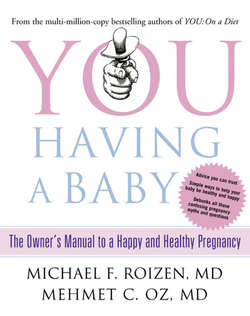Читать книгу You: Having a Baby: The Owner’s Manual to a Happy and Healthy Pregnancy - Michael Roizen F. - Страница 39
A Perfect Placenta: The Big Usual Picture
ОглавлениеVery soon, you’re going to be making some important decisions about what and how to feed your newborn. Mashed yams or soupy peas? Cheerios or cut-up fries? Natural or artificial nipple? While those are certainly big decisions, we think you’re making a mistake if you fast-forward all of your concerns about nutrition to the moment when Homer Jr. is searching for his first sip from breast or bottle.
In fact, the time you need to start thinking about feeding your baby is the moment you know you’re pregnant (even beforehand, actually), because when you’re pregnant, that’s exactly what you are doing: feeding your baby through your placenta.
The placenta, with one smooth surface and one that looks a lot like a plate of congealed spaghetti, is responsible for the exchange of all nutrients and waste products between the mother and fetus. (See figure 2.2.) It basically functions like this: Mom’s blood flows into the blood lake on her side of the placenta, which bathes the chorionic villi that are threaded through with fetal blood vessels. Small molecules and nutrients (oxygen, glucose, vitamins, fatty acids, calcium, some antibodies, and so on) flow from mom to baby, and waste products (carbon dioxide, urine, and metabolic wastes) flow from baby to mom.*
Weighing in at about one and a quarter pounds when fully grown, the placenta works like a two-way filter. (See figure 2.2.) Stuff goes through it from one side to the other and vice versa. But here’s the thing: The placenta is no Brita. It doesn’t necessarily screen out the bad and only let the good pass through. The placenta lets everything through below a certain size and blocks insulin, heparin, and other large molecules that would otherwise cause immune rejection or other problems.† That means any toxins that make the size cut can get passed to the fetus, whether it’s gunk from cigarettes, saturated and trans fats, alcohol, or other nasty substances.
One of the reasons we care so much about a mother’s health during pregnancy is that it will influence the way the placenta functions by determining the amount of surface area of the placenta available for the efficient exchange of nutrients. For example, smoking or having uncontrolled hypertension or diabetes can cause your placenta to calcify, thus limiting the area available for the proper exchange between mother and fetus. As you can guess, that limits the amount of nutrients that the fetus can receive and can lead to issues that have a major influence on your baby’s health both inside the womb and down the road.
Of course, it should go without saying that placental formation doesn’t always go as smoothly as we all hope. That’s because of the delicate conditions it takes for the placenta to develop and the dangerous journey that the blastocyst makes to the uterine wall. Placental issues that can threaten mom’s health and lead to an increased risk of prematurity include:
Figure 2.2 Feeding Time The miraculous placenta serves a number of functions-most important, as the bridge between baby and mom. Filtering nutrients (as well as oxygen and toxins), the placenta passes along everything that mom ingests or inhales. The placenta also serves an immunity role, helping to pass along mom’s immune cells’ immunity before the fetus can develop such immunity on his own.
Placenta Previa: This happens when the placenta attaches itself to the lower part of the uterus and covers the opening to the cervix. While it often moves up and away from the cervix as the uterus grows larger during pregnancy, it can cause heavy bleeding at the end of the pregnancy if it doesn’t (in which case, you might need a cesarean section). If you have placenta previa, your prescription will include no sex and no exercise. However, if it’s diagnosed early in the second trimester, there’s a good chance the issue will resolve itself.
Placental Abruption: This happens when some of the placenta separates from the uterine wall, which increases the risk of cutting off oxygen from the baby. Bed rest can help if the separation is small, but if it’s a major separation, the doc will determine if the child’s lungs are mature enough to handle delivery. Some conditions can predispose a woman to abruption; your provider will discuss these with you if you’re at risk. These include but are not limited to blunt trauma, uncontrolled high blood pressure, cocaine use, and smoking.
